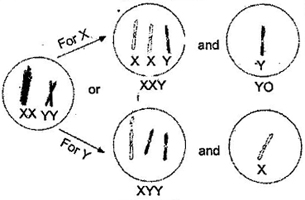What is Sex Mosaics in Genetics?
In genetics, a mosaic denotes the presence of two or more populations of cells with different genotypes i.e. different chromosome number in one individual who has developed from a single fertilized egg. Mosaicism may result from a mutation during development which is propagated to only a subset of the adult cells. There are three causes known that result in mosaics.
The first includes the mitotic non-disjunction of sex chromosomes, which occurs in similar manner that found in meiosis. In a male zygote (XY), there may be non-disjunction of X chromosome or there is non-disjunction of Y chromosome. In the first case, one cell line will have XXY and YO chromosome. While the second possibility resulting in cell lines: XYY and XO.

In a female zygote non-disjunction would result in “XXX” and “XO” cell lines.

The second includes the chromosomal lagging, in which the X chromosome may lag and thus, during anaphase it fail to reach the pole to be integrated in the daughter nucleus and it disintegrates in the cytoplasm giving rise to daughter cells of chromosomal complement AAXY and AAXO. For example, in Drosophila, the developing embryo of AAXX females and AAXO males will have the mixture of both. Flies having such chromosomal complement are known as gynandromorphs or gynanders and also sex mosaics.
In humans, the karyotypes of some, sex chromosome mosaics are XX/X, XY/X, XX/XY, and “XXX/X”. In XX/X persons, one line of cells has one X chromosome whereas the other has two Xs. Similarly, in “XXX/X” individuals, one cell line has three Xs and the other has one X.
The third cause of the development of mosaics is through dispermic fertilization, which is seen in XX/XY chimera. During this phenomenon, one X-bearing and the other Y- bearing sperm fuse with the nucleus and polar bodies of egg respectively to form ‘zygote’, which develop into one individual.
There is extreme possibility of occurring the mosaics to some degree in many persons in the population, which appears normal phenotypically, but may have a reproductive risk i.e. apart of their gonadal cells could be chromosomally abnormal. These mosaic persons are not gynandaomorphs i.e. the discrete patches of definite male or definite female tissues are absent. The abnormal number of chromosome due to non-disjunction can affect autosomes and sex chromosomes, which are known as various chromosomal anomalies.


